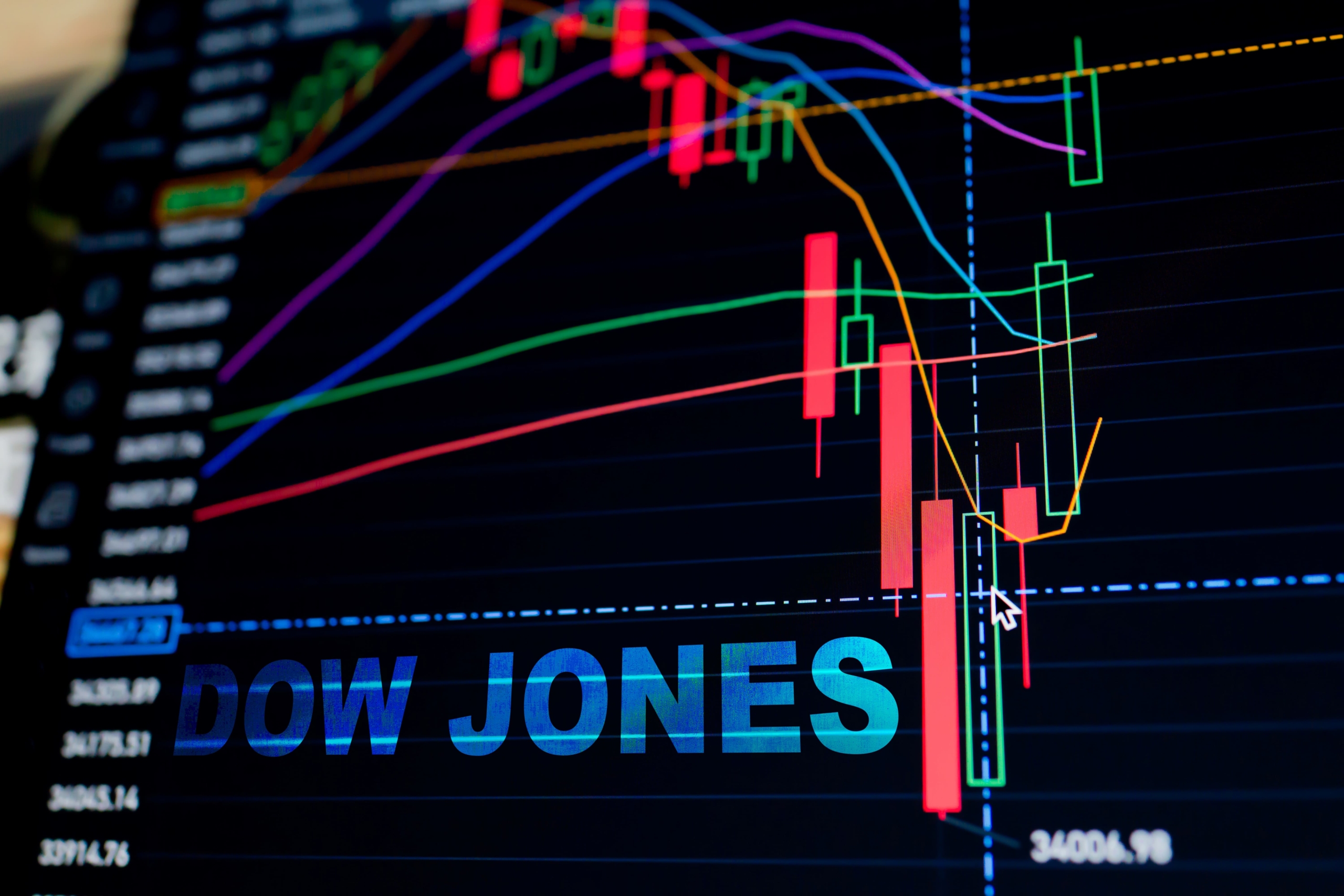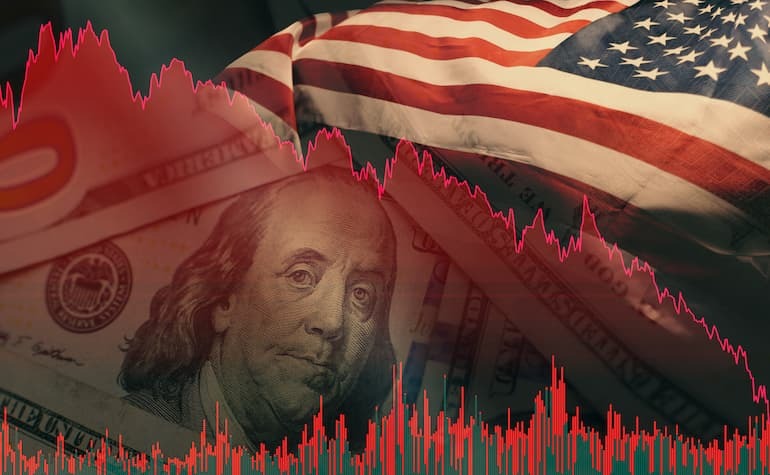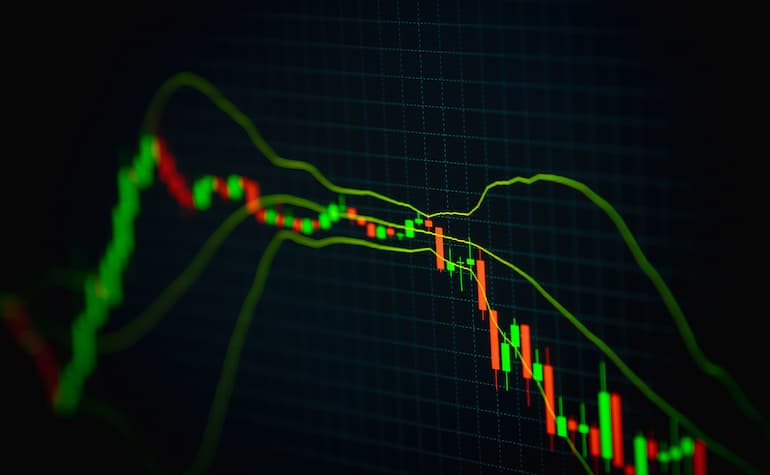市场资讯及洞察
%20(1).jpg)
本来今天想聊聊澳洲央行副行长最近公开谈到的有关澳洲有可能陷入经济低速增长的怪圈的问题,但是想想过去几篇文章都是说澳洲的,自己都觉得有点过于多了。但是很多内容不是我不想说,说国内经济情况,就怕你懂的,说欧美呢,估计大家也没啥兴趣看,说数字货币,也容易被黄标,导致我都不知道说什么好。那想来想去,最近看似比较大的事件就是美国国会关于预算用完,政府停摆的讨论的。
我们都知道,几乎每年来那么一次的停摆,今年又来了。这次停摆的时间再次打破历史记录,到上周末为止,已经超过38天了。没钱发工资、预算批不下来、议会还在吵。看着熟悉吧?因为这已经不是第一次了。过去10年,美国政府停摆过4次,每次都是在最后一刻“凑合”过关。从奥巴马到拜登,再到现在的老川,都一样。
有人说这就是美国政治的一部分,可在投资眼里,这更像是一种系统性疲态——就是那个世界最强信用体的裂缝,越来越多了。而且每次的解决方案都是很不要脸的继续提高债务上限,换句话说就是多印一点美元。
BUT, 就算再无赖,也得按照自己定的规矩来:
美国财政部的数字摆在那儿:
截至2025年10月底,美国的联邦总债务已经突破34.9万亿美元,还在以每秒钟大约4万美元的速度增加。光是2024财年,财政赤字就超过1.7万亿美元。而且更离谱的是,光“还利息”这一项,2025年预计就要花掉1.1万亿美元。什么意思?
就是美国政府借的钱,不是用来搞建设、科研或就业,而是越来越多地在还旧账的利息。这像不像信用卡欠多了,每月只够还最低额?加入一艘航母需要1000亿美元造价(不包括后期维护保养),那每年美国国债需要支付的利息就等于10艘航母的造价。
再看点细的。现在美国政府每收进1块钱税,大概要花掉1块三。财政支出和收入差了三成,完全靠举债撑着。以前大家信美国债是“无风险收益”,现在越来越多的投资机构开始犹豫了。这么每年收100花130,总不是个办法啊,这要是某一天出现点啥问题,是不是之前发美债的都有可能不算了?
那我们老百姓这么想,自然其他国家也会担忧。所以到2024年底,日本和中国这两大美国国债持有人,都在减持美债。日本在过去一年里减少了大概500亿美元持仓,中国更是创下了十年新低,只剩不到7700亿美元。
什么意思?全球主要买家在撤退。买这个美元纸币,太没有安全感了。买了也不是自己的,说查封就查封,说不能用就不能用。这算什么?当甲方还要这么受气。
讲真,这种对美元信用体系开始怀疑的局面在历史上是第一次。美国长期靠发债维持政府运转、靠美元霸权转嫁通胀。可现在,财政失衡、政治对抗、地缘风险……都在削弱那个“美元信仰”。
你想啊,美元强的底层逻辑是什么?是航母和F22,哦不对,说错,重来啊,美元的底层逻辑是什么?是信任。
大家相信美国政府永远能还钱、永远有能力印钱、永远不会倒。可现在连他们自己内部都吵得不可开交,国会关门、债务上限拉扯、甚至连总统都公开说“预算快撑不住”。美元的信任体系开始打折。
这时候你就得想:如果世界对美元信心动摇,那资金往哪跑?
答案其实很简单——黄金。(其实数字货币也起到了部分作用,但是因为过于分散,种类太多,导致资金无法集中)
别看黄金没利息、也不分红,但它有个谁都替代不了的特性:它不是谁欠谁的债。
你拿着美债,信的是美国政府的信用;你拿着黄金,信的是全人类几千年的共识。几千年前的埃及法老都爱这个,肯定没错。
最近几个月黄金的表现也印证了这点。
2024年年底,国际金价突破每盎司2400美元的新高,到了2025年10月,又一次冲上2500美元附近。你说这只是地缘政治?那只是表面。深层原因,是全球在寻找美元之外的安全锚。
咱看印度、土耳其、俄罗斯这些国家央行,去年都在疯狂买金。根据世界黄金协会的数据,2024年各国央行净增持黄金超1000吨,创下历史第二高。
这说明:连各国政府都不太敢再押宝美元。我的看法很简单:
黄金这波不是短线冲动,而是长期趋势在切换。
美元几十年的霸权红利,靠的是全球信任。可当信任开始松动,这个故事的主角可能要换了。除非美国再次把老二老三整服气了,之后各位小弟就会再次对大哥的地位不会质疑了。作为群众,咱们其实不希望看到这一天到来,不论结局谁赢,期间的不可控因素太多,一旦一个不小心,咱们就要见证咱们现代人类最后的辉煌了。
最后,我不建议大家一股脑地“梭哈黄金”,但起码你得让自己有点配置。就像以前老人说的——“仓里没点金,心里没底气。”
那具体咋搞?
你可以分几种方式:
1. 实物金:最笨但最踏实。买金币、金条,放保险箱。但是每次买卖差价几乎等于价格的10%,交易成本极高。
2. 纸黄金/ETF:操作灵活,适合不想拿实物的人。缺点是,手里没有那个沉甸甸的金子,总感觉只是个数字而已。
3. 黄金矿业股:风险高、弹性大,适合激进投资者。这个就看人品了,如果运气好,5倍10倍不是梦,当然,更大的机率是,没挖到,宝马变单车。
从长远来看,我个人倾向于使用自己资金10-30%购买ETF作为“稳健基础”。这不是投机,而是保险。你不指望它天天涨,但万一美元系统出事,它能救你一命。
再说一句现实点的。
现在美国债务增长速度远高于GDP增长。也就是说,他们靠印钱维持系统平衡。通胀虽然被压了一点,但核心通胀还在3%左右,远高于美联储2%的目标。
这意味着:美联储降息空间有限,财政却还要继续借钱。
那结果?
货币越来越多,信用越来越稀。
黄金,就是对冲这种“信用通胀”的最好工具。
有人问:“那美元真的会崩吗?”
麦哥的回答是:不会马上崩,但它会慢慢失去神圣光环。这不,11艘航母还是很厉害的。
历史上没有哪个超级货币能永远称王。英镑用了100多年从巅峰掉下来,美元可能也会经历同样过程。如果大家学过历史应该可以知道,黄金在1971年美元脱钩后,从每盎司35美元涨到现在的2500美元。它没变,是货币的实际价值在变。
所以,简单总结:
美国政府停摆也许能暂时拖过去,债务上限也许能再抬一点,但信任这种东西,一旦开始透支,就很难补回来。你不能指望一个连工资都快发不出的政府,永远当世界的“信用中心”。美元可能还会强一阵子,但我认为黄金这波超级大牛市,才刚刚开始。
各位读者,我不是劝你买金发财,而是提醒你:这个世界的信用体系,正在慢慢换轨。
写完以后,赶紧用上网乘着黑五买一堆没用的垃圾。虽然咱们知道黄金美丽,价格长虹,但是咱日常生活,还是纸币方便啊。
生活还得过,但是咱们脑子不能糊涂。对吧?
免责声明:GO Markets 分析师或外部发言人提供的信息基于其独立分析或个人经验。所表达的观点或交易风格仅代表其个人;并不代表 GO Markets 的观点或立场。
联系方式:
墨尔本 03 8658 0603
悉尼 02 9188 0418
中国地区(中文) 400 120 8537中国地区(英文) +248 4 671 903
作者:
Mike Huang | GO Markets 销售总监


Index trading is one of the most popular class of markets to trade for CFD traders, rivalling major FX pairs in trading volume, but what is indices trading and how does trading them with CFDs work? Most people will be familiar with the names of the major stock indices from financial reports in all forms of media, the most popular stock indices of CFD traders and the stocks they track are below: USA The Dow Jones Industrial average - 30 largest blue-chip companies in the US NASDAQ Composite Index – Top 100 largest non-financial companies in the US (Mostly Tech) S&P 500 Index - 500 large cap companies in the US (Bank heavy) Europe and UK FTSE 100 – Top 100 UK companies CAC 40 – Top 40 French companies DAX 40 – Top 40 German companies (Formerly known as the DAX30 which it may still be labelled as) Asia and Australia ASX 200 – Top 200 Australian companies Hang Seng - A selection of the largest companies in Hong Kong. Nikkei 225 - Consists of 225 stocks in the Prime Market of the Tokyo Stock Exchange Some of the advantages of trading indices: You can take a broad view of the health (or not) of that countries stock market, i.e. rather than take a position in a single stock, take a position in a basket of stocks by buying or selling the index they are components of.
Higher leverage available to trade stock indices, up to 100:1 for qualified Pro clients. Extended trading hours, you can take positions in most indices up to 23 hours a day, far greater hours than the underlying stock exchanges. Take positions long or short with ease to profit from both a rising and falling market.
When you take a Long (Buy) position you profit if the market moves up, a Short (Sell) position will profit when the market moves down. How Indices are priced and understanding your position size Stock Indices are priced in the native currency i.e., the Dow Jones (WS30 on the GO Markets platform) is priced in USD, the FTSE100 in GBP, the ASX200 in AUD etc. This is important to keep in mind when choosing your position size, it also important to know the specifications of the contract you are trading is to make sure you understand the lot sizing before entering a trade.
You can check the specifications of any contract on MT4 and MT5 by right clicking it in the Market Watch Window and selecting “Specification” An example specification of the Dow (WS30) is below (MT4 specs, MT5 is very similar): You can see in the example above that the WS30 contract with GO Markets has a contract size of 1, this means 1 lot will equal $1 USD per point movement in PnL if you take a position. e.g., if you buy 1 lot at a price of 33670 and the price rises to 33680 you are in profit by 10 points, which would equal $10 USD Most indices will have a contract size of 1, though it is advisable to always check as some may have different values, an example in the S&P 500 (US500) which has a contract size of 10. It is important to understand the contract size and base currency of the index you are trading before entering a trade to avoid any nasty surprises. Main drivers of what moves an Index’s price.
In choosing which Index to trade it is also important to understand the drivers of that index and it’s component stocks. All Indexes will have some common drivers, such as global growth concerns, geopolitical events and non-US indices will be affected (fairly or not) by what US markets are doing. Each index will also have its own individual drivers as well though.
Examples The NASDAQ (NDX100) is heavily weighted with mega cap tech stocks, the health of the Tech sector will heavily influence its price. The ASX200 and FTSE100 both have large contingents of miners, meaning commodity prices will be big drivers of these 2 indexes, more so the ASX200. The Russell 2000 has many regional and mid-size banks as its component stocks, which is why during the recent banking crisis it underperformed other US indices.
Understanding these unique drivers for each Index is recommended to make the best trading decisions possible. In Summary, trading Indices opens up some great opportunities to position yourself to profit from market moves, spreads on Indices with GO Markets are some of the best in the CFD industry, with tight spreads in and out of hours( Some brokers will artificially increase spreads on Indices outside the stock market hours of that country) They allow you to seamlessly take long or short positions to speculate for profit, or to headge existing stock positions from an overnight move. You can click the link below to learn more about Index trading with GO Markets. https://www.gomarkets.com/au/index-trading-cfds/


The US Dollar Index (DXY) is a popular tool used by forex traders to assess the value of the US dollar relative to a basket of other major currencies. The DXY is calculated using the weighted average of six major currencies: the euro, yen, pound sterling, Canadian dollar, Swedish krona, and Swiss franc. To use the DXY to trade forex, you can follow these steps: 1.
Monitor the DXY: Keep an eye on the movements of the DXY to get a sense of the overall strength or weakness of the US dollar. You can use technical analysis tools, such as moving averages or trend lines, to identify the direction of the trend. 2. Analyse currency pairs Look for forex pairs that are inversely correlated to the DXY.
This means that when the DXY goes up, the currency pair goes down, and vice versa. For example, the EUR/USD pair is negatively correlated to the DXY, which means that as the DXY goes up, the EUR/USD pair goes down. Plan your trades Once you have identified a currency pair that is inversely correlated to the DXY, you can plan your trades accordingly.
For example, if the DXY is showing signs of weakness, you may want to consider going long on a negatively correlated currency pair, such as the EUR/USD. Manage your risk As with any trading strategy, it's important to manage your risk when using the DXY to trade forex. Make sure to use stop-loss orders to limit your losses in case the market moves against you.
Currency pairs may be influenced by other factors besides the DXY, which may not be a perfect indicator of the US dollar's value. To make informed trading decisions, it is important to combine the DXY with other technical and fundamental analysis tools.


Gold had been trading strongly to the upside since the beginning of March, rising from the 1810 price area to reach the 2000 price area which was last tested in April 2022. However, after reaching the resistance area, Gold retraced lower to test the 1937.50 support area which coincides with the 38.2% Fibonacci retracement level and the bullish trendline. Currently, Gold is forming a double top chart pattern as the price again retraces from the resistance level at 2000.
With the Moving Average Convergence and Divergence (MACD) indicator signaling a potential bearish reversal, a confirmation of further downside potential could be signaled if Gold breaks below the bullish trendline. This could see the price trade lower to test the 1917 level, and beyond that, the 1887 support level which coincides with the 61.8% Fibonacci retracement level. Significant moves to the downside on Gold is likely to be driven by a recovery in the strength of the DXY, due to its inverse correlation with the reserve commodity.
Alternatively, if the market uncertainty increases, arising from further developments in the banking crisis or increased concern over possible global inflation, Gold could trade higher beyond the 2000 resistance level, which would invalidate the double-top formation. A continuation of the uptrend could see Gold trade toward the next resistance level of 2070, which was last reached in March 2022.


USDJPY The USDJPY is on the march higher again after a better than expected Non-Farm payroll figure on Friday saw sentiment shift hawkishly toward Fed monetary policy with Fed fund futures now pricing in a 70% chance of a 25bp hike at the FOMC May meeting, up from around a 50-50 split earlier in the week. The policy divergence in the US and Japan and the subsequent yield differentials on their respective 10 year government bonds has been the main driver of this pair in the last 12 months. You can see the close relationship of this in the chart below.
The black line is the difference between 10 year yields on US 10 years – Japanese 10 year years, the orange line, the USDJPY rate. As the US yields increase their gap to their Japanese counterparts, the USDJPY will be pressured upwards as traders look for low risk carry trades. The Yen was also not helped recently by comments from the new incoming governor of the BoJ that indicated that any change to the current dovish policy was not imminent.
Key levels to watch USDJPY has been forming a textbook uptrend since late March. With the upward trend line tested and holding as support on a handful of occasions, a resistance level of 133.85 has so far held any further upside, but is looking vulnerable. Ways to trade this are 1, Playing the range, buying low at the trendline, selling high at the resistance level.
Though whilst the uptrend is in place the more cautious approach would be to stick to buys. 2, Waiting for a break of these levels for the next push. The longer this takes, and the tighter the range gets the more explosive this move could be. While economic announcements out of Japan are very light on the ground this week, The US will be releasing both CPI and PPI figures, how these inflation figures look will have a measurable effect on market sentiment towards Federal Reserve policy and will almost certainly see some big moves in the USD and rates markets, so the break of this range may come as early as tomorrow night.


American manufacturer of farm machinery and industrial equipment Deere & Company (NYSE:DE) announced the latest financial results for the quarter ending January 29, 2023, before the market open in the US on Friday. Revenue was reported at $12.652 billion for the quarter (up by 32% year-over-year) vs. $11.337 billion expected. Earnings per share also topped analyst estimates at $6.55 per share vs. an estimate of $5.565 per share.
The company expects revenue of between $8.75 to $9.25 billion in the fiscal year 2023. CEO commentary ''Deere’s first-quarter performance is a reflection of favorable market fundamentals and healthy demand for our equipment as well as solid execution on the part of our employees, dealers, and suppliers to get products to our customers,'' CEO of the company, John C. May said in a press release. ''We are, at the same time, benefiting from an improved operating environment, which is contributing to higher levels of production,'' May concluded.
Stock reaction Shares of Deere were up around 5% at the market open on Friday, trading at $427.32 a share. Stock performance 1 month: -1.38% 3 months: -2.43% Year-to-date: -6.02% 1 year: +5.89% Deere & Company stock price targets Stifel: $477 Citigroup: $505 BMO Capital: $450 Wells Fargo: $485 Morgan Stanley: $522 Argus Research: $475 Credit Suisse: $582 JP Morgan: $440 UBS: $452 Deutsche Bank: $374 Goldman Sachs: $420 Citigroup: $425 Deere & Company is the 114 th largest company in the world with a market cap of $119.74 billion. You can trade Deere & Company (NYSE:DE) and many other stocks from the NYSE, NASDAQ, HKEX, ASX, LSE and DE with GO Markets as a Share CFD.
Sources: Deere & Company, TradingView, MarketWatch, MetaTrader 5, Benzinga, CompaniesMarketCap


Bollinger Bands are one of the most popular indicators that FX and CFD traders use, invented in the 1980’s they are a technical analysis tool that are widely used by short and long term traders. The main uses for Bollinger Bands is determining turning points in the market at oversold and overbought levels and also as a trend following indicator. Like any technical indicator Bollinger Bands should be used with your own analysis to confirm trades and help set entry and exit levels, they are a fairly simple indicator that focuses on price and volatility only and shouldn’t, in my opinion be used in isolation.
While effective, to use them successfully you will need to be aware of the fundamentals and other technical indicators such as major support or resistance levels. How Bollinger Bands are calculated Bollinger Bands are composed of three lines. The middle line is a simple moving average (SMA), the default period being 20.
The upper and lower bands are the SMA plus or minus 2 standard deviations by default, the SMA period and Deviations can be adjusted in the settings of the indicator if desired, but the standard settings are the most popular settings among traders. When the price hits the upper band the market could be seen as “overbought” when it hits the lower band it could be seen as “oversold”, they can also be used as levels where trends are confirmed, e.g. hitting upper band could be seen as the start of a strong uptrend and vice versa. Day Trading strategies using Bollinger Bands Bollinger Bands are used mainly in two different trading styles, for contrarians looking for overbought and oversold levels to enter fade trades, or confirmation of trend for trend following systems. Both systems have their pros and cons, as with most indicators it will depend on the market “fee” for the time used, a choppy whipsawing market will see the fading system work very well, a strong trending market will see the trend following system work very well.
As with any technical system, the selection of the market to trade and being aware of the fundamentals driving the FX market at that time are critical.. Just had a Fed meeting where they surprised with a 100bp rate hike? Don’t use the fade system on USD pairs!
A good technical system I have found is useful is a mixture of both of these strategies, using the Bollinger Bands to confirm a trend, then using the fading strategy to trade pullbacks of this trend. Lets look at the example below from the AUDNZD – 5 minute chart from the 23 rd March 2023 In the above example, which is a common price action across all FX pairs, you would be using the Bolling Bands to confirm a down trend after a close below a major low. Once the possible trend is confirmed, we will be using the “overbought” level of the upper band to enter a short trade, with a take profit exit on 2 closes below the lower band, indicating the market may have gone into “oversold” territory and was time to take some money off the table.
This process would be repeated while lower highs were being made, a close above a major recent high along with a close above the upper Bollinger Band would indicate the trend may have come to an end. This can be seen on the chart below, later in the session on the same pair. At this point you would exit the short selling of the down trend and reverse to a long bias, or if your analysis on fundamentals were negative for this pair, wait for a new downtrend to form for another shorting run.
The Bollinger Squeeze Strategy Another strategy popular with FX traders is known as the Bollinger squeeze strategy. A squeeze occurs when the price has a big move, then consolidates in a tight range, this also sees the Bollinger bands go from wide to “squeeze” in a much narrower range, hence the name of the strategy. A trader would be looking for a breakout and close below or above the Bollinger bands of this squeezed range for a trade entry, see the example below from the EURUSD 5 Minute chart on 23 rd of March 2023 When the price breaks through the upper or lower band after this period of consolidation a buy or a sell signal is generated.
An initial stop is traditionally placed just above (or below in a long position) the range of the consolidation. TP rules could be similar to the previous strategy, i.e. multiple closes below the lower Bollinger Bans in the case of a short, or using the middle Bollinger Band as a trailing stop in the move is explosive and looks to continue. Summary As you can see there are multiple uses for Bollinger Bands in a FX day traders toolbox, including using them for overbought and oversold trade signals in a trending market and the Squeeze strategy where an explosive move often follows a period of consolidation.
There are also many more strategies using this indicator which I encourage you to research for yourself.

